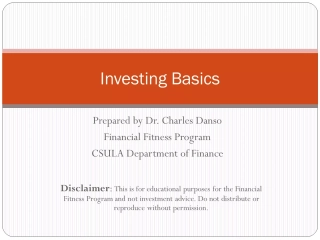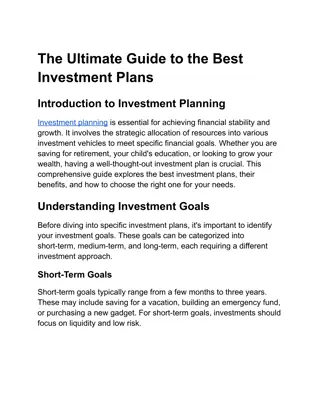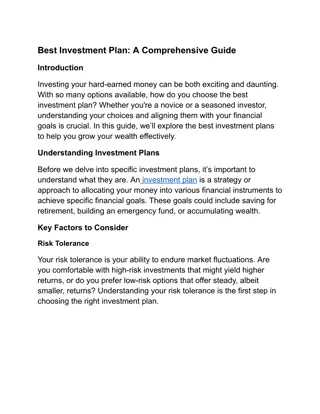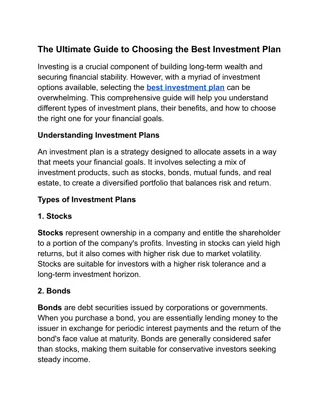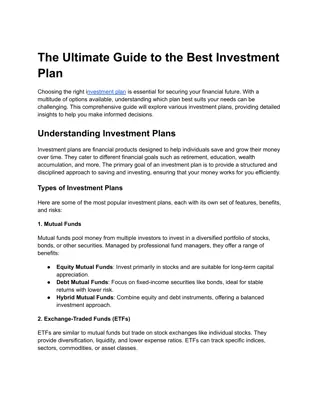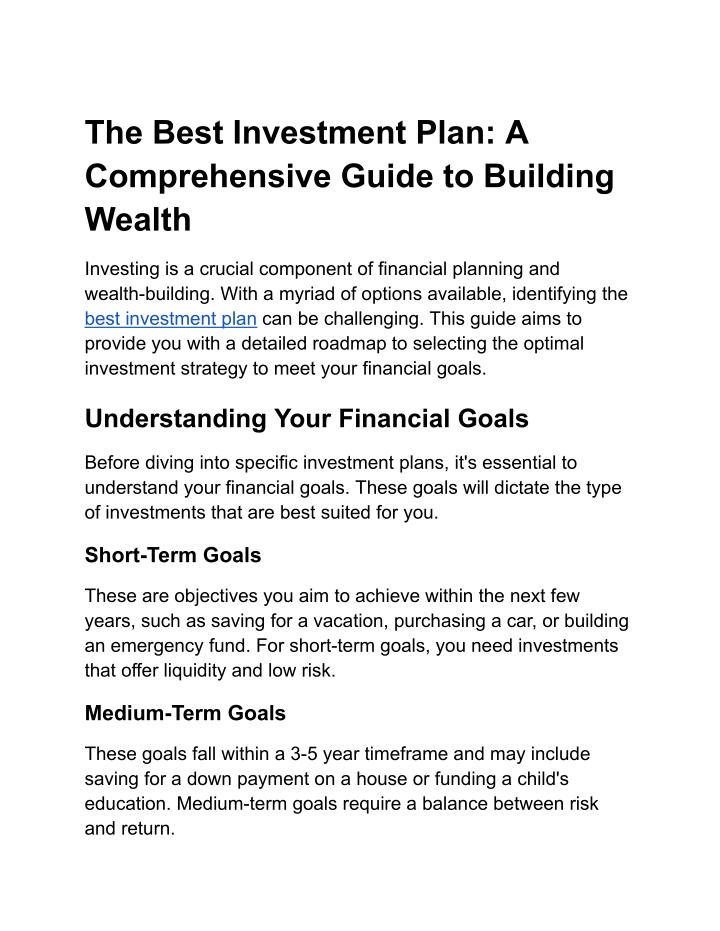
The Best Investment Plan_ A Comprehensive Guide to Building Wealth
Investing is a crucial component of financial planning and wealth-building. With a myriad of options available, identifying the best investment plan can be challenging. This guide aims to provide you with a detailed roadmap to selecting the optimal investment strategy to meet your financial goals.n
Uploaded on | 1 Views
Download Presentation

Please find below an Image/Link to download the presentation.
The content on the website is provided AS IS for your information and personal use only. It may not be sold, licensed, or shared on other websites without obtaining consent from the author. If you encounter any issues during the download, it is possible that the publisher has removed the file from their server.
You are allowed to download the files provided on this website for personal or commercial use, subject to the condition that they are used lawfully. All files are the property of their respective owners.
The content on the website is provided AS IS for your information and personal use only. It may not be sold, licensed, or shared on other websites without obtaining consent from the author.
E N D
Presentation Transcript
The Best Investment Plan: A Comprehensive Guide to Building Wealth Investing is a crucial component of financial planning and wealth-building. With a myriad of options available, identifying the best investment plan can be challenging. This guide aims to provide you with a detailed roadmap to selecting the optimal investment strategy to meet your financial goals. Understanding Your Financial Goals Before diving into specific investment plans, it's essential to understand your financial goals. These goals will dictate the type of investments that are best suited for you. Short-Term Goals These are objectives you aim to achieve within the next few years, such as saving for a vacation, purchasing a car, or building an emergency fund. For short-term goals, you need investments that offer liquidity and low risk. Medium-Term Goals These goals fall within a 3-5 year timeframe and may include saving for a down payment on a house or funding a child's education. Medium-term goals require a balance between risk and return.
Long-Term Goals Long-term goals, such as retirement or long-term wealth accumulation, span over a decade or more. These goals can afford higher risk investments that offer significant growth potential. Key Investment Options Stocks Stocks represent ownership in a company and offer high growth potential, making them suitable for long-term investors. While stocks can be volatile, they historically provide higher returns compared to other asset classes. Diversifying your stock portfolio can mitigate risks. Bonds Bonds are debt securities issued by corporations or governments. They provide regular interest payments and return the principal at maturity. Bonds are less volatile than stocks and can be a good choice for medium-term goals and for balancing risk in your portfolio. Mutual Funds Mutual funds pool money from multiple investors to invest in a diversified portfolio of stocks, bonds, or other securities. They are managed by professional fund managers and offer diversification, which reduces risk. Mutual funds are suitable for all types of investors, depending on the fund's investment strategy.
Exchange-Traded Funds (ETFs) ETFs are similar to mutual funds but trade like stocks on an exchange. They offer diversification and typically have lower fees than mutual funds. ETFs can be an excellent option for both short-term and long-term investors. Real Estate Investing in real estate involves purchasing property to generate rental income or to sell at a profit. Real estate can provide steady cash flow and potential appreciation but requires significant capital and management. Retirement Accounts Retirement accounts, such as 401(k)s and IRAs, offer tax advantages that help your investments grow faster. These accounts are specifically designed for long-term goals, particularly retirement, and often provide employer matching contributions. High-Yield Savings Accounts For short-term goals, high-yield savings accounts offer better interest rates than traditional savings accounts. They provide liquidity and safety, making them ideal for emergency funds or short-term savings. Building a Diversified Portfolio Diversification is key to managing risk and achieving balanced growth. A diversified portfolio includes a mix of asset classes that perform differently under various market conditions.
Asset Allocation Asset allocation involves spreading your investments across different asset classes stocks, bonds, real estate, etc. based on your risk tolerance and investment horizon. A common strategy is the 60/40 rule, where 60% of the portfolio is allocated to stocks and 40% to bonds, but this can be adjusted based on individual goals and risk preferences. Rebalancing Regular rebalancing ensures that your portfolio stays aligned with your investment goals and risk tolerance. For example, if stocks perform exceptionally well, they might constitute a larger portion of your portfolio than intended. Rebalancing involves selling some of the high-performing assets and reinvesting in underperforming ones to maintain your desired asset allocation. Choosing the Right Investment Plan Assess Your Risk Tolerance Your risk tolerance is your ability and willingness to endure market volatility. Younger investors with a longer investment horizon can typically afford higher risk investments, while older investors may prefer more conservative options. Determine Your Investment Horizon Your investment horizon the time you plan to hold your investments affects your choice of investment. Long-term investors can invest in higher-risk assets for potentially higher
returns, whereas short-term investors should focus on lower-risk, more liquid investments. Consider Your Current Financial Situation Evaluate your current financial situation, including your income, expenses, debts, and savings. Ensure you have an emergency fund and are not over-leveraging your investments. Seek Professional Advice Financial advisors can provide personalized advice based on your financial goals, risk tolerance, and investment horizon. They can help you create a tailored investment plan and adjust it as your circumstances change. Top Investment Plans for 2024 Index Funds and ETFs Index funds and ETFs that track market indices like the S&P 500 offer low-cost exposure to a broad market segment. They are ideal for long-term growth and diversification. Target-Date Funds Target-date funds automatically adjust the asset allocation based on your retirement date. These funds become more conservative as the target date approaches, making them suitable for retirement planning.
Robo-Advisors Robo-advisors provide automated, algorithm-driven financial planning services with minimal human intervention. They are cost-effective and offer diversified portfolios tailored to your risk profile and goals. Dividend Growth Stocks Investing in companies with a history of growing dividends can provide a steady income stream and potential for capital appreciation. These stocks are suitable for income-focused investors. Real Estate Investment Trusts (REITs) REITs allow you to invest in real estate without owning physical property. They provide high liquidity and regular income through dividends, making them a good choice for income and diversification. Conclusion Choosing the best investment plan involves understanding your financial goals, risk tolerance, and investment horizon. A diversified portfolio that includes a mix of asset classes tailored to your specific needs can help you achieve financial success. Regularly reviewing and adjusting your investment plan ensures it remains aligned with your evolving financial situation.

